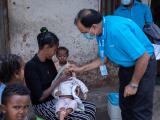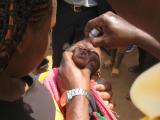Aug 30, 2012
Ferrets shown to spread H1N1 well before symptoms develop
Pandemic 2009 H1N1 flu appears to be readily transmissible by both direct contact and through the air before clinical symptoms appear, according to a small study in ferrets published yesterday in PLoS One. Researchers from Imperial College London placed infected ferrets either in the same cage as other ferrets or in adjacent cages to assess direct-contact and respiratory droplet transmission, respectively. They found that all three ferrets sharing a cage with an animal 1 to 2 days after it was infected (but well before it showed signs of illness) also became infected, and that two of three ferrets became infected via respiratory droplets, according to the study. The third ferret exposed to respiratory droplets became seropositive but did not exhibit clinical disease. They found that efficient transmission did not correlate with respiratory signs such as coughs and sneezes but did correlate with peak viral load in the nose. In fact, ferrets sharing a cage with an animal during the respiratory-symptom stage of illness not only did not get sick but remained seronegative.
Aug 29 PLoS One study
Two severe illnesses in Missouri caused by novel virus
Researchers from the US Centers for Disease Control and Prevention say they have identified a novel phlebovirus as the cause of severe illnesses in two Missouri farmers. One patient, a previously healthy 57-year-old man, was hospitalized for 10 days after a tick bite; the other, a 67-year-old man with type 2 diabetes, was hospitalized for 12 days after receiving numerous tick bites, according to the authors' report in today's New England Journal of Medicine. The patients suffered from fever, fatigue, anorexia, nonbloody diarrhea, and, in one case, headache. Both men recovered, but one of them said he has had fatigue and recurrent headaches in the 2 years since the illness. The initially suspected cause of the illnesses was Ehrlichia chaffeensis, but it was not found. Electron miscrocopy suggested the possibility of a bunyavirus (the family that includes phleboviruses), and sequencing and phylogenetic analysis led to the conclusion that the pathogen was a novel phlebovirus, which the authors call the Heartland virus. "Although Koch's postulates [for establishing a causal link between a microorganism and a disease] have not been completely fulfilled, our findings are consistent with the identification of a new pathogenic virus in the United States," the article states. "This novel virus . . . is a distinct member of the phlebovirus genus and is most closely related to tickborne phleboviruses, notably the recently isolated SFTSV." The authors did not determine which tick species carried the virus, but one possibility is the lone star tick, which is abundant in Missouri, they write.
Aug 30 N Engl J Med abstract
Nigeria reports 4 new polio cases
Nigeria has reported four new cases of polio in Yobe state, according to a News Agency of Nigeria (NAN) story yesterday. The cases were in Damaturu, Karasuwa, and Gulani Local Government Areas. The two cases in Damaturu were in areas with "high security risk," according to a local World Health Organization coordinator, which means officials cannot risk sending immunization teams there. Although polio cases started the year at lower levels in Nigeria compared with recent years, the nation continues to experience sporadic outbreaks.



















